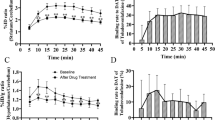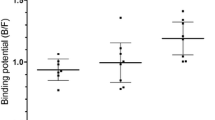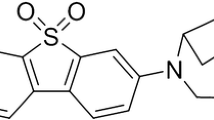Abstract
Purpose
Antagonism of norepinephrine reuptake is now an important pharmacological strategy in the treatment of anxiety and depressive disorders, and many antidepressants have substantial potential occupancy of the norepinephrine transporter (NET) at recommended dosages. Despite the importance of understanding this transporter’s role in psychiatric disease and treatment, a suitable radioligand for studying NET has been slow to emerge. (S,S)-Methylreboxetine (MRB) is among the more promising ligands recently adapted for positron emission tomography (PET), and the present study aimed to evaluate its potential for use in higher primates.
Methods
Affinities for various brain targets were determined in vitro. PET studies were conducted in baboon under both test–retest and blocking conditions using 1 mg/kg nisoxetine.
Results
MRB has sixfold higher affinity for NET than the serotonin transporter, and negligible affinity for other sites. PET studies in baboons showed little regional heterogeneity in binding and were minimally affected by pretreatment with the NET antagonist nisoxetine.
Conclusion
Despite improvement over previous ligands for imaging NET in vivo, the low signal to noise ratio indicates [11C]MRB lacks sensitivity and reliability as a PET radiotracer in humans.






Similar content being viewed by others
References
Brunswick DJ, Benmansour S, Tejani-Butt SM, Hauptmann M. Effects of high-dose methamphetamine on monoamine uptake sites in rat brain measured by quantitative autoradiography. Synapse 1992;11:287–93.
Logan J, Ding YS, Lin KS, Pareto D, Fowler J, Biegon A. Modeling and analysis of PET studies with norepinephrine transporter ligands: the search for a reference region. Nucl Med Biol 2005;32:531–42.
Tejani-Butt SM. [3H]nisoxetine: a radioligand for quantitation of norepinephrine uptake sites by autoradiography or by homogenate binding. J Pharmacol Exp Ther 1992;260:427–36.
Versteeg DH, Van Der Gugten J, De Jong W, Palkovits M. Regional concentrations of noradrenaline and dopamine in rat brain. Brain Res 1976;113:563–74.
Charnay Y, Leger L, Vallet PG, Hof PR, Jouvet M, Bouras C. [3H]Nisoxetine binding sites in the cat brain: an autoradiographic study. Neuroscience 1995;69:259–70.
Wilson AA, Johnson DP, Mozley D, Hussey D, Ginovart N, Nobrega J, et al. Synthesis and in vivo evaluation of novel radiotracers for the in vivo imaging of the norepinephrine transporter. Nucl Med Biol 2003;30:85–92.
Schou M, Halldin C, Sovago J, Pike VW, Gulyas B, Mozley PD, et al. Specific in vivo binding to the norepinephrine transporter demonstrated with the PET radioligand, (S,S)-[11C]MeNER. Nucl Med Biol 2003;30:707–14.
Ding YS, Lin KS, Logan J, Benveniste H, Carter P. Comparative evaluation of positron emission tomography radiotracers for imaging the norepinephrine transporter: (S,S) and (R,R) enantiomers of reboxetine analogs ([11C]methylreboxetine, 3-Cl-[11C]methylreboxetine and [18F]fluororeboxetine), (R)-[11C]nisoxetine, [11C]oxaprotiline and [11C]lortalamine. J Neurochem 2005;94:337–51.
Prabhakaran J, Majo VJ, Mann JJ, Kumar JS. Chiral synthesis of (2S,3S)-2-(2-morpholin-2-yl-2-phenylmethoxy)phenol. Chirality 2004;16:168–73.
Milak MS, Ogden RT, Vinocur DN, Van Heertum RL, Cooper TB, Mann JJ, et al. Effects of tryptophan depletion on the binding of [11C]-DASB to the serotonin transporter in baboons: response to acute serotonin deficiency. Biol Psychiatry 2005;57:102–6.
Wong DT, Threlkeld PG, Best KL, Bymaster FP. A new inhibitor of norepinephrine uptake devoid of affinity for receptors in rat brain. J Pharmacol Exp Ther 1982;222:61–5.
Parsey RV, Ogden RT, Mann JJ. Determination of volume of distribution using likelihood estimation in graphical analysis: elimination of estimation bias. J Cereb Blood Flow Metab 2003;23:1471–8.
Schroeder C, Adams F, Boschmann M, Tank J, Haertter S, Diedrich A, et al. Phenotypical evidence for a gender difference in cardiac norepinephrine transporter function. Am J Physiol Regul Integr Comp Physiol 2004;286:851–6.
Seneca N, Gulyas B, Varrone A, Schou M, Airaksinen A, Tauscher J, et al. Atomoxetine occupies the norepinephrine transporter in a dose-dependent fashion: a PET study in nonhuman primate brain using (S,S)-[18F]FMeNER-D2. Psychopharmacology (Berl) 2006;188:119–27.
Acknowledgements
The authors thank Holly Brandenburg and Mali Pratap for their assistance with PET studies, and the NIMH-PDSP for ligand assay services. This work was supported by PHS grant MH062185.
Author information
Authors and Affiliations
Corresponding author
Rights and permissions
About this article
Cite this article
Severance, A.J., Milak, M.S., Kumar, J.S.D. et al. In vivo assessment of [11C]MRB as a prospective PET ligand for imaging the norepinephrine transporter. Eur J Nucl Med Mol Imaging 34, 688–693 (2007). https://doi.org/10.1007/s00259-006-0312-2
Received:
Accepted:
Published:
Issue Date:
DOI: https://doi.org/10.1007/s00259-006-0312-2




